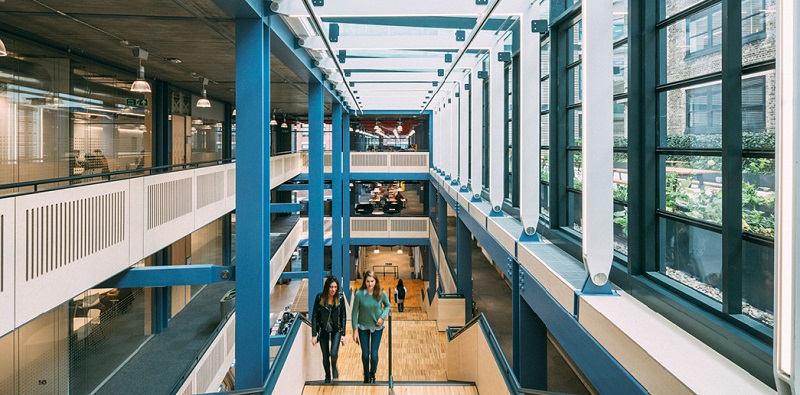Centre Building at LSE

|
| Image courtesy of Rogers Stirk Harbour + Partners |
In September 2019, the London School of Economics and Political Science (LSE) opened its latest landmark building to students, staff and alumni.
The Centre Building, which cost £78m to construct as part of an overall investment of £125m in developing LSE’s campus, was designed by internationally renowned architect Rogers Stirk Harbour + Partners (RSHP) and delivered by international consultancy and construction company Mace.
Situated at the heart of LSE’s campus, on Houghton Street and Clare Market, the 13-storey building is the largest building commissioned in LSE’s history. A bold and beautiful design, it is also the highest building on campus, offering spectacular views across London’s skyline.

|
| Image courtesy of Rogers Stirk Harbour + Partners |
Julian Robinson, Director of Estates at LSE, said: “This building delivers on the two key tenets of our estates strategy, creating a world-class estate and a university quarter in this part of London. The Centre Building, with its emphasis on sustainability, community and collaboration, has created an inspiring academic environment within which to work and study that will enhance the campus experience for our students, staff, alumni and visitors.”
Tracy Meller, Partner and architect, Rogers Stirk Harbour + Partners said: "The Centre Building project presented us with a unique opportunity to work with the LSE to design a building which really reflects the values of the school, creating innovative and inspirational spaces for students and staff, in which to learn, socialise, study and collaborate. Our proposals went beyond the original brief aspirations placing a new public square at the heart of the campus to improve wayfinding and connectivity, and to give the LSE a much-needed new focal point. Embracing sustainable design principles from the offset, the BREEAM Outstanding building provides good daylighting and natural ventilation to over 70% of the accommodation, creating workspaces which enhance the wellbeing of its occupants. In addition, it reduces embodied carbon by 30%, harvests rainwater and utilises a biomass boiler and PVs as part of its renewable energy strategy."
Terry Spraggett, Mace’s Managing Director of Public Sector Construction said: “We’re proud to have supported LSE in delivering this landmark building, which forms an integral part of the university’s continued ambition to create world class facilities for its students and staff. Sustainability was a core component of the delivery strategy and the Centre Building will be the first on the campus to achieve a BREAAM ‘outstanding’ rating, further cementing LSE’s reputation as a forward-thinking institution. Working with LSE and our excellent supply chain, we’ve created a high-spec building with state-of-the-art teaching and learning facilities that will foster collaboration and innovation for years to come.”

|
| Image courtesy of Rogers Stirk Harbour + Partners |
The Centre Building hosts a number of academic departments, more than a dozen seminar rooms, hundreds of study spaces and four lecture theatres, including an innovative ‘LSE style theatre’ designed to allow for both traditional style teaching and collaborative group work. A new LSE Alumni Centre provides a custom-designed space for alumni visiting their campus, while three roof terraces and a café provide new areas for students and staff to meet and socialise.
To facilitate interaction, a public square has been placed at the heart of the building, creating a new focal point for students and staff to interact while linking Houghton Street to the Library Plaza and connecting Lincoln’s Inn Fields on the western edge of the campus to the LSE buildings to the east. The building also features a dramatic ‘academic stair’. Moving diagonally across the façade of the building in a series of double height spaces, the staircase was designed to encourage dialogue between departments, institutes and research centres and to provide additional informal areas for students and staff to interact.
The Centre Building – which achieved a BREEAM ‘outstanding’ rating – houses the Department of Government, Department of International Relations, European Institute, International Inequalities Institute and School of Public Policy and the LSE Directorate.
In June 2020, this announcement was made: Centre Building at LSE shortlisted for RIBA award.
Rogers Stirk Harbour + Partners is an international architectural practice based in London. Over the past four decades, RSHP has attracted critical acclaim and awards with built projects across Europe, the Americas, Asia and Australia.
The practice is experienced in designing a wide range of building types including: office, residential, transport, education, culture, leisure, retail, civic and healthcare. The quality of its designs has been recognised with some of architecture’s highest awards, including two RIBA Stirling Prizes, one in 2006 for Terminal 4, Madrid Barajas Airport and the other in 2009 for Maggie’s West London Centre.
Education projects designed by the practice include: Mossbourne Community Academy in London; Minami Yamashiro Elementary School in Kyoto; and Thames Valley University in Slough.
This article was written by Vicki Macgregor, Strategic Communications & Marketing Manager at RSHP. It was previously published on the RSHP website in September 2019 and can be accessed HERE.
More articles by RSH+P on Designing Buildings Wiki can be found HERE.
[edit] Related articles on Designing Buildings Wiki
- 3 World Trade Center.
- 8 Chifley.
- 88 Wood Street.
- Antwerp Law Courts.
- BBVA Bancomer headquarters.
- Billingsgate Market.
- Bodegas Protos.
- Bordeaux Law Courts.
- British Library extension.
- British Museum World Conservation and Exhibitions Centre.
- Centre Building at LSE shortlisted for RIBA award.
- Centre Pompidou.
- Cancer Centre at Guy's Hospital.
- Channel Four Television Headquarters.
- CIOB 2020 CMYA and Rising Stars Announced.
- Conservation and storage facility for the Musée du Louvre.
- Daimler Chrysler office and retail.
- European Court of Human Rights.
- Heathrow Terminal 5
- Inmos Microprocessor Factory.
- International Spy Museum.
- International Towers Sydney.
- Leadenhall Building.
- Lloyd's of London.
- Lloyd's Register.
- Macallan Distillery and Visitor Experience.
- Madrid Barajas Airport.
- Maggie's Centre.
- McArthurGlen Designer Outlet Ashford.
- Merano by RSHP recognised in RIBA Awards.
- National Assembly for Wales.
- NEO Bankside.
- Nuovo Centro Civico - Scandicci.
- One Hyde Park.
- One Park Taipei.
- Taiwan Taoyuan International Airport Terminal 3.
--RSHP
Featured articles and news
Gregor Harvie argues that AI is state-sanctioned theft of IP.
Many resources for visitors aswell as new features for members.
Using technology to empower communities
The Community data platform; capturing the DNA of a place and fostering participation, for better design.
Heat pump and wind turbine sound calculations for PDRs
MCS publish updated sound calculation standards for permitted development installations.
Homes England creates largest housing-led site in the North
Successful, 34 hectare land acquisition with the residential allocation now completed.
Scottish apprenticeship training proposals
General support although better accountability and transparency is sought.
The history of building regulations
A story of belated action in response to crisis.
Moisture, fire safety and emerging trends in living walls
How wet is your wall?
Current policy explained and newly published consultation by the UK and Welsh Governments.
British architecture 1919–39. Book review.
Conservation of listed prefabs in Moseley.
Energy industry calls for urgent reform.
Heritage staff wellbeing at work survey.
A five minute introduction.
50th Golden anniversary ECA Edmundson apprentice award
Showcasing the very best electrotechnical and engineering services for half a century.
Welsh government consults on HRBs and reg changes
Seeking feedback on a new regulatory regime and a broad range of issues.
CIOB Client Guide (2nd edition) March 2025
Free download covering statutory dutyholder roles under the Building Safety Act and much more.
























